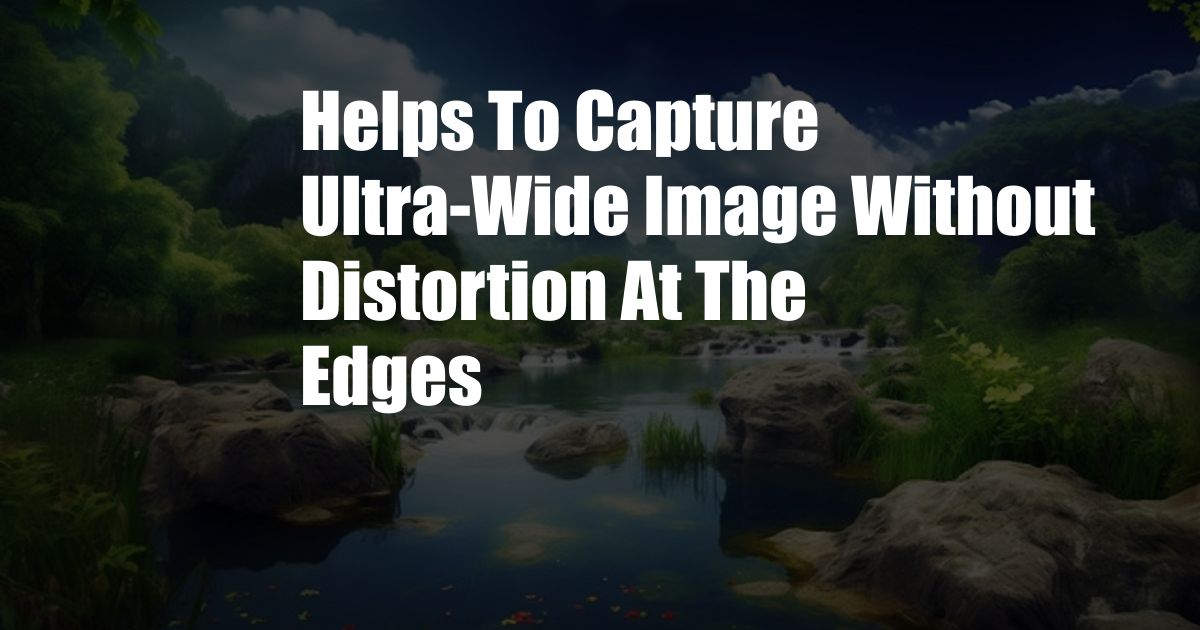
Capturing Ultra-Wide Images without Distortion: A Comprehensive Guide
In the realm of photography, capturing expansive vistas and breathtaking panoramas is an art form that requires specialized techniques. One of the most significant challenges that photographers often face is the distortion that can occur at the edges of ultra-wide images. This distortion, known as fisheye effect, can make images appear skewed and unnatural. In this comprehensive guide, we will explore the intricacies of capturing ultra-wide images without distortion, providing you with the knowledge and techniques to create visually stunning and immersive photographs.
Before delving into the specifics, let’s define ultra-wide lenses and their unique characteristics. Ultra-wide lenses typically have a focal length of 16mm or less, offering an extremely wide field of view that allows photographers to capture a vast expanse of the scene in a single frame. While this wide field of view can be captivating, it also introduces the potential for distortion due to the curvature of the lens.
Minimizing Distortion in Ultra-Wide Photography
To minimize distortion in ultra-wide photography, several techniques can be employed. Let’s delve into each technique in detail.
- Avoid Subject Placement at Extremes: Distortion is most pronounced at the edges of the frame, where the lens’s curvature is most evident. To minimize distortion, avoid placing important subjects too close to the edges. Instead, position them near the center of the frame where distortion is less noticeable.
- Utilize Tilt-Shift Lenses: Tilt-shift lenses are specialized lenses that allow for both tilt and shift movements. By tilting the lens, you can correct for converging verticals, which can occur when the camera is tilted upwards. Shifting the lens allows you to move the center of perspective, which can help reduce distortion on one side of the frame.
- Employ Software Correction: Many post-processing software programs offer tools specifically designed to correct distortion. These tools can be highly effective in removing fisheye effect and other distortions from ultra-wide images. However, it’s important to use these tools judiciously to avoid over-correction, which can result in unnatural-looking images.
- Experiment with Focal Length: Choosing the right focal length is crucial in ultra-wide photography. If possible, use a lens with a slightly longer focal length, such as 18mm or 20mm, instead of an ultra-wide lens with a 10mm or 12mm focal length. Longer focal lengths can help reduce distortion while still providing a wide field of view.
- Use a Full-Frame Sensor: Cameras with full-frame sensors are less susceptible to distortion than cameras with smaller sensors. This is because the larger sensor size allows for a wider field of view without the need for extreme focal lengths, which can introduce distortion.
Expert Advice for Tackling Distortion in Ultra-Wide Photography
In addition to the technical techniques discussed above, seasoned photographers recommend the following tips for capturing ultra-wide images without distortion:
- Plan Your Composition Carefully: Before you start shooting, take the time to plan your composition and identify potential areas where distortion could occur. By doing this, you can adjust your subject placement or camera angle to minimize the impact of distortion.
- Experiment with Different Perspectives: Don’t be afraid to experiment with different perspectives when shooting ultra-wide images. Try shooting from a lower or higher angle, or move your camera around to find the best composition that minimizes distortion.
- Use a Tripod: Using a tripod will help stabilize your camera and prevent camera shake, which can exacerbate distortion. A sturdy tripod will also allow you to use slower shutter speeds and wider apertures, which can further reduce distortion.
- Shoot in Raw Format: Capturing your images in raw format will give you more flexibility when correcting distortion in post-processing. Raw files contain more data than JPEGs, which allows you to make more extensive adjustments without compromising image quality.
Frequently Asked Questions (FAQs) about Ultra-Wide Photography
Here are some frequently asked questions (FAQs) about ultra-wide photography:
- What is the best lens for ultra-wide photography?
The best lens for ultra-wide photography depends on your camera and the specific needs of your project. Generally, lenses with a focal length of 16mm or less are considered ultra-wide. Some popular options include the Canon EF 16-35mm f/2.8L III USM and the Nikon AF-S NIKKOR 16-35mm f/4G ED VR. - How do I prevent my ultra-wide images from looking distorted?
To prevent your ultra-wide images from looking distorted, avoid placing important subjects too close to the edges of the frame, use tilt-shift lenses or software correction to fix distortion, experiment with different focal lengths, and use a tripod for stability. - Can I correct distortion in post-processing?
Yes, you can correct distortion in post-processing using software such as Adobe Photoshop or Lightroom. However, it’s important to note that over-correcting can result in unnatural-looking images.
Conclusion
Capturing ultra-wide images without distortion requires a combination of technical knowledge and creative experimentation. By understanding the principles of distortion, employing the techniques discussed in this article, and seeking advice from experienced photographers, you can master ultra-wide photography and create visually stunning images that convey the expansive beauty of the world around you. As a passionate photographer, I encourage you to embrace the challenges of ultra-wide photography and explore the endless possibilities it offers.
Are you ready to embark on your ultra-wide photography journey and capture breathtaking images without distortion?